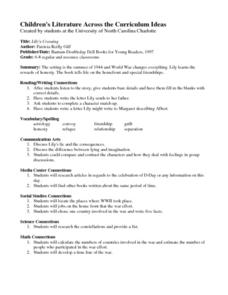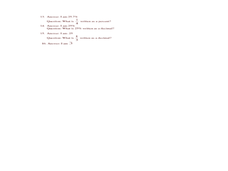Curated OER
Stay Focused on Long Division
Students utilize a checklist in order to help them stay focused on long division problems.
Curated OER
Graphing Equivalent Fractions
Students graph families of equivalent fractions and compare them by observing the slope of the line formed by each fraction family. They place fractions in ascending order by comparing the slopes of each line after several families of...
Curated OER
Lesson Plan fo The Magic Eyes of Little Crab
Interested in a "how and why" story to read with young students? In this storytelling activity, readers will discuss sea creatures, focusing on practicing new terminology through retelling the story. This resource provides a list of...
Curated OER
On the Track With NASCAR
Students complete a variety of activities to research stock car racing. They use the Internet to research NASCAR acronyms, schedules, results, car design and other aspects.
Curated OER
Children's Literature Across the Curriculum Ideas-Two Eyes, A Nose, and A Mouth
Students read Two Eyes, A Nose, and A Mouth by Roberta Grobel Intrater. They complete a variety of cross-curricular activities surrounding faces and facial features. Included are reading, art, math, science, writing, social studies, and...
Curated OER
Lily's Crossing
Students listen to a story, "Lily's Crossing," about life during a World War. After completing worksheets, they compare and contrast characters in the story. Using math skills, students develop a time line of the war, calculate the...
Curated OER
Children's Literature Across the Curriculum Ideas-The Christmas Miracle of Jonathan Toomey
Students read The Christmas Miracle of Jonathan Toomey by Susan Wojacieckowski. They complete a variety of cross-curricular activities surrounding the Christmas holiday. Included are reading, art, math, science, writing, social studies,...
Curated OER
Mental Strategies For Multiplication And Division
Students engage in a lesson plan that is concerned with the use of mental strategies for multiplication and division. They develop the cognitive skills through repetition exercises that include mental exercises like "Mad Minutes...
Curated OER
Minutes and Hours
In this mathematics worksheet, 1st graders identify about how long it takes to do each task illustrated. Then they do three things that take minutes to complete and three things that take hours to complete.
Curated OER
Mathematicians Research Projects
Students research a famous mathematician and create a presentation of their research. In this famous mathematician research lesson, students decide on a famous mathematician that they would like to learn more about. They conduct research...
Curated OER
Sea and Learn - Lesson Plan: Dockyard Maties
Pupils solve word problems involving money using all four operations listed, and convert pre-decimal currency into decimal currency. They discuss how dockyard mates were paid and the equivalence with today's money, and complete a...
Curated OER
JAPAN, IMAGES A PEOPLE
Students interpret Japanese and American paintings; evaluate paintings as sources of cultural and historical information
Curated OER
Patterns
Fifth graders explore patterns. In groups, 5th graders participate in a "Pasta Pattern" activity. Given a bag of pasta, classmates sort pasta by shapes. They use pasta pieces to model different patterns. Students complete a bean...
Curated OER
Ratios
Sixth graders pariticipate in a lesson that focuses on the finding of a ratio and using it to set up a proportion in realtionship to creating a scale drawing. This is done using given problems. It would be valuable for students to have...
Curated OER
Money
Students use play coins to solve problems. They imagine that someone handed them two coins. One is a quater and one is a dime. Students are asked by feeling the shapes of the coins, how could they tell which one was the quater? They are...
Curated OER
Andromeda's Scale
Students perform a classroom activity of measuring the angular size of something from several distances. On the Internet, they obtain and examine images with various magnification factors and estimate the angular size of Andromeda.
Curated OER
Area: Algebra/Geometry Institute Summer 2009
Students compute the area of a rectangle. In this area lesson, students measure the sides of rectangles and squares. They cut figures, measure them, and determine the area of each given figure. Students justify their...
Curated OER
How Big is it?
Students review the units of the metric system, convert from the US system of units of measure to the metric system, and estimate measures before converting between the two systems of measurement.
Curated OER
Lost King of the Maya
Students are introduced to the Mayan Long Count calendar system. They work in groups to calculate the date of their birth and use the calendar to determine important Mayan dates.
Curated OER
Scaling Down Art
Students change the scale of a work of art using ratios, percentages, and proportions. While this is technically an art instructional activity, there is quite a bit of mathematics involved in converting to the correct scale.
Curated OER
Relating Fractions, Decimals and Percents
Young scholars convert numbers to fractions, decimals and percents. In this conversion lesson, students convert fractions, decimals and percents to a specified form. Groups of young scholars play a conversion index card...
Curated OER
Volume of Rectangular Prisms: Algebra/Geometry Institute Summer 2009
Students find the volume of rectangular prisms. In this volume lesson, students use a formula to find the volume of rectangular prisms. They discuss the definition of volume and draw rectangular prisms. Students...
Curated OER
Brute Force and Other Algorithms
Young scholars discuss why it can be difficult to solve word problems. In this algorithm lesson, students review better methods to outline word problems and solve the problem of the Ice Cream Stands. They discuss how the name Brute Force...
Curated OER
Interdisciplinary Lesson Plan- Math
Learners perform locomotor movement. In this locomotor skills lesson, students practice running, hopping, skipping, and walking then form themselves into groups based on a number called out. Learners identify if more or less...

























